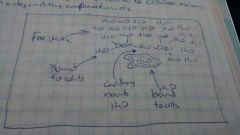![]()
![]()
![]()
Use LEFT and RIGHT arrow keys to navigate between flashcards;
Use UP and DOWN arrow keys to flip the card;
H to show hint;
A reads text to speech;
39 Cards in this Set
- Front
- Back
- 3rd side (hint)
|
What types of sludge contain more organic matter and how much? |
Primary sludge and activated sludge (70 and 75% organic matter) |
|
|
|
Sludge composition |
99% water 1 % solids (70-80% organics) |
|
|
|
Dry solids Sludge production in netherlands per year |
350,000 tons |
|
|
|
Amount of solids after thickening |
5 to 8 % dry solids in sludge |
|
|
|
Water types of bounds |

Free water Capillary bound Cell bound |
|
|
|
The .... The organic solids fraction, the ... The water fraction. Then, higher destruction of organic matter is pursued to have ... Volume of Sludge |
High High Less |
|
|
|
How much Volume is reduced during thickening by every 1 % of dry solids increase |
50 % |
|
|
|
Types of thickeners |
Gravitational or mechanical compression |
|
|
|
Gravitational thickener size |
Dm = 5 - 25 meters Depth = 3 - 5 meters |
|
|
|
Solids loading rate (thickener) |
Vds = Q x S / A Vds kg SS/ m2.day |
|
|
|
Max solids loading rate for primary sludge, activated sludge and its combination |
100 - 150 20 - 30 30 - 50 |
|
|
|
Solids retention time |
Sludge Volume thickener / daily sludge flow from thickener 1 day |
|
|
|
Advantages of sludge digestion |
Biogas Hygiene No odours Stabilizes sludge Reduces organic fraction and volume Improves dewatering, adsorbs les water than fresh sludge |
|
|
|
How much energy does 1 kg of COD represents |
0.35 m3 of CH4 or 3.8 Kwh Considering non degradable COD it is 0.12 m3 of CH4 |
CH4 and kwh |
|
|
Influent of 100 kg of COD how is it split after aerobial digestion |
Effluent 2 - 10 kg COD Sludge 30 - 60 kg COD |
|
|
|
How much energy of the biogas can be transformed into electricity? |
35 - 40 % |
|
|
|
First types of digesters |
Septic tank Imhoff tank Clarigester Separate digestion tank |
|
|
|
Retention time for mesophilic and thermophilic conditions |
30 - 35 days for mesophilic 15 days for thermophilic |
|
|
|
Sludge digester size |
Height:diameter 1:1 Volume 1000 - 10,000m3 Feeding semicontinuously |
|
|
|
Energy required for heating a mesophilic digestor in summer and winter |
120 mJ / m3 winter 85 mJ/m3 summer |
|
|
|
How much biogas is produced per kilogram of destroyed organic matter? |
1000 litters of biogas |
|
|
|
Caloric value of biogas |
24 mJ per m3 or 6.67 kwh |
|
|
|
How much organic matter is reduced after digestion? |
50 % |
|
|
|
Can stalized sludge be used in agricultural purposes? |
No because of heavy metals |
|
|
|
After dewatering de expect sludge with .... % dry solids |
20 - 30 % |
|
|
|
Types of dewatering |
Chemical and thermal |
|
|
|
Chemical dewatering, what is it? |
Addition of lime or ferric chloride. 300 g/ kg SS. Poly electrolites 3 - 8 g/ kg SS |
|
|
|
Dewatering by thermal means, what is it? |
200 °C and high pressure |
|
|
|
Equipments for dewatering |
Centrifugation: demands more energy and polyelectrolytes press Filter belt press Chamber filter press: demands more personal but up to 35% ds |
|
|
|
Influent of 100 kg of COD how is it split after anaerobial digestion |
5 kg sludge 10 - 20 kg effluent Rest to biogas |
|
|
|
How much m3 CH4 is produced per kg of COD removed |
0.08 to 0.12 m3 |
|
|
|
Advantages of UASB reactor |
Retains suspended solids in general Retains anaerobial activated sludge Stabilizes sludge Mineralizes organics CH4 CO2 |
|
|
|
Parts of a UASB reactor |
Primary clarifier Biorreactor Secondary clarifier Sludge digester |
|
|
|
COD, BOD, SS removal in UASB reactor |
From 70 to 85% |
|
|
|
COD influent, SS influent, HRT and temperature for a UASB |
<1000 mg/l COD <500 mg/l SS >20°C HRT 8 hours |
|
|
|
Upward velocities in a UASB |
0.7 m/h |
|
|
|
UASB height |
5 to 6 meters |
|
|
|
What are the baffles for in a UASB |
Prevents biogas from reaching the secondary clarifier zone |
|
|
|
Max volume of a UASB |
2000 m3 |
|

